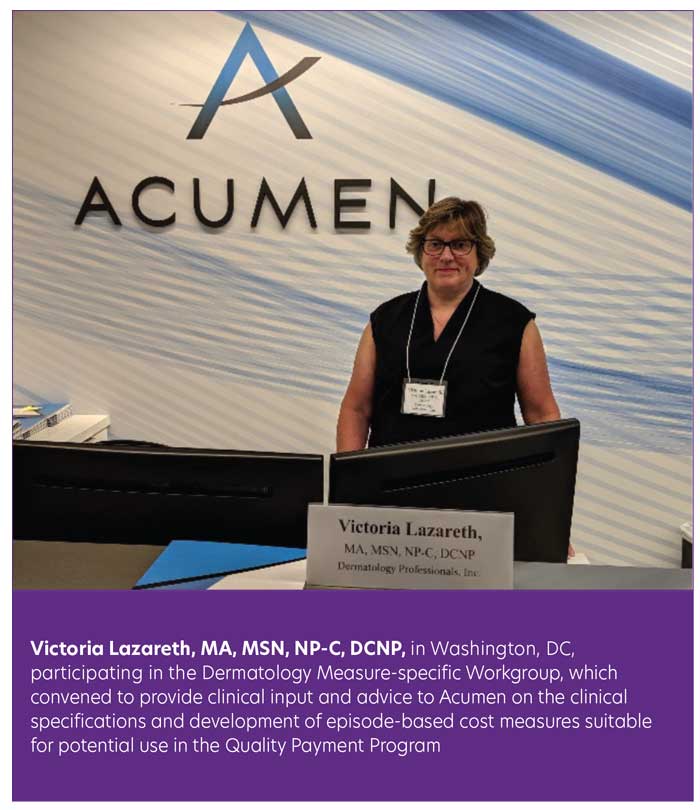 Victoria Lazareth MA, MSN, NP-C, DCNP is a Board Certified Dermatology Nurse Practitioner and co-founder of the Society of Dermatology Nurse Practitioners. She serves on the Dermatology Nurse Practitioner Certification Board, as Affiliate professor of Dermatology for Simmons University Boston and as faculty for the Center for Advanced Practice Dermatology, MauiDerm NP/PA and other professional conferences. She is a contributing author to the text Dermatology for Advanced Practice Clinicians: Essential Knowledge and Skills, a content reviewer for the Journal of the Dermatology Nurses’ Association and has contributed several peer-reviewed articles to the dermatology literature. She provides general dermatology care and sub-specializes in cutaneous oncology, Transplant Dermatology and Dermatologic Surgery.
Victoria Lazareth MA, MSN, NP-C, DCNP is a Board Certified Dermatology Nurse Practitioner and co-founder of the Society of Dermatology Nurse Practitioners. She serves on the Dermatology Nurse Practitioner Certification Board, as Affiliate professor of Dermatology for Simmons University Boston and as faculty for the Center for Advanced Practice Dermatology, MauiDerm NP/PA and other professional conferences. She is a contributing author to the text Dermatology for Advanced Practice Clinicians: Essential Knowledge and Skills, a content reviewer for the Journal of the Dermatology Nurses’ Association and has contributed several peer-reviewed articles to the dermatology literature. She provides general dermatology care and sub-specializes in cutaneous oncology, Transplant Dermatology and Dermatologic Surgery.
Dear Colleagues:
Welcome to the September edition of NP+PA Perspectives in Dermatology. It is my pleasure to serve on the editorial advisory board of NP+PA Perspectives, and it is an honor to also serve as this edition’s Guest Editor.
Before I introduce the articles in this edition of NP+PA Perspectives, I would like to take this opportunity to highlight the ongoing efforts by the Centers for Medicare and Medicaid Services (CMS), along with statistical analysts, stakeholders, and expert providers from multiple fields of medicine, to establish the Quality Payment Program.
Medicare the Medicare Access and CHIP Reauthorization Act of 2015 (MACRA) is legislation that was created to change the way Medicare rewards clinicians for value over volume of care. It repealed the Sustainable Growth Rate formula and combined multiple quality programs under a new Merit-based Incentive Payments System (MIPS). It also provides bonus payments to clinicians for participation in eligible Alternative Payment Models (APMs). While MACRA has been met with mixed reviews by the dermatology community, patient volume and procedures limited by the coronavirus would negatively affect productivity and bonuses for providers in 2020, compromising productivity benchmarks.
 In order to meet the requirements of MACRA, the Centers for Medicare & Medicaid Services (CMS) contracted with a statistical analysis firm (Acumen, LLC) to develop care episode and patient condition groups for use in cost measures. Acumen convened groups of stakeholders and experts to provide direction and input for development of episode-based cost measures. These clinician expert panels were organized into Clinical Subcommittees to focus on specific clinic areas of practice. Acumen then convened the Clinical Subcommittees in cycles of development called “waves.” The first wave included experts from the following clinical areas: cardiovascular, gastrointestinal, musculoskeletal, neuropsychiatric; ophthalmologic, peripheral vascular, and pulmonary disease. This wave convened in 2017. The second wave comprised experts from musculoskeletal—spine; oncologic—medical, radiation, & surgical; renal; and urologic disease, convening in 2018. And the third wave included experts from chronic condition & disease; dermatologic disease management; general & colorectal surgery; and hospital medicine, which convened in 2019. Members of these subcommittees were tasked to develop procedural and/or acute, inpatient, medical-condition, episode-based cost and quality measures to establish best practices.
In order to meet the requirements of MACRA, the Centers for Medicare & Medicaid Services (CMS) contracted with a statistical analysis firm (Acumen, LLC) to develop care episode and patient condition groups for use in cost measures. Acumen convened groups of stakeholders and experts to provide direction and input for development of episode-based cost measures. These clinician expert panels were organized into Clinical Subcommittees to focus on specific clinic areas of practice. Acumen then convened the Clinical Subcommittees in cycles of development called “waves.” The first wave included experts from the following clinical areas: cardiovascular, gastrointestinal, musculoskeletal, neuropsychiatric; ophthalmologic, peripheral vascular, and pulmonary disease. This wave convened in 2017. The second wave comprised experts from musculoskeletal—spine; oncologic—medical, radiation, & surgical; renal; and urologic disease, convening in 2018. And the third wave included experts from chronic condition & disease; dermatologic disease management; general & colorectal surgery; and hospital medicine, which convened in 2019. Members of these subcommittees were tasked to develop procedural and/or acute, inpatient, medical-condition, episode-based cost and quality measures to establish best practices.
I was selected to represent dermatology NPs and PAs, and joined 20 physicians including dermatologists, dermatopathologists, Mohs surgeons, plastic surgeons, oncologists and radiation oncologists from across the nation to compose the MACRA Episode-Based Cost Measures Clinical Subcommittee for Dermatologic Disease Management. The primary objective for the subcommittee was to develop episode-based cost measures for use in the Quality Payment Program.
Subsequent to an initial virtual meeting, the Dermatologic Disease Management Subcommittee met at Acumen headquarters in Washington, DC, on June 30, 2019. The primary focus for this meeting was to select which episode-based cost measure to develop. This proved more challenging than anticipated.
Acumen provided total numbers and percentages of payments made by Medicare for cutaneous conditions. Not surprisingly, in the over-65- years age group, significant payments are made for the care of cancerous and pre-cancerous lesions. Treatment of actinic keratoses constitutes a marked financial burden on this patient population; however, establishing statistical benchmarks would prove difficult due to the multiple treatment options approved for these lesions. The sheer volume of nonmelanoma or keratinocytic skin cancers is also very significant, but it was determined that conclusive statistical analyses would be compromised due to the many clinical and regional variances in the approach to treatment.
It was determined that while fewer in number, management of melanomas would provide the most uniform standard for measure. The subcommittee then discussed the measure intent and provided input on the desired composition of the workgroup that was to be established to build out the selected measure.
I was also selected to join the Dermatology Measure-specific Workgroup which returned to Washington, DC, to meet on August 22, 2019. The focus of this meeting was to provide clinical input and advice to Acumen on the clinical specifications and development of episode-based cost measures suitable for potential use in the Quality Payment Program.
The working group discussed the specifications and measures to refine episode group triggers (i.e., initial biopsy vs excision); to recommend what services should be included in episode-based cost measure (i.e., slow Mohs, imaging, special tissue staining); and to recommend the length of the episode window (i.e., surgery vs radiation or medical oncology services). The group also evaluated strategies to recommend sub-groups to compare like patients and to recommend risk adjustment variables to include in the risk adjustment model. We also made determinations to recommend measure exclusion criteria (i.e., ocular, genital and mucosal melanomas).
The next step for Wave 3 of episode-based, cost-measure development, which is currently in process, is a five-week field testing period from August to September 2020.
Value-based care has been shown to improve efficacy and outcomes in certain disciplines (e.g., myocardial infarction in emergency care, pneumonia in primary care). However, its usefulness in dermatology remains to be established. Given the lack of clear measures of success and the chronicity of many cutaneous conditions, value-based care needs further evaluation to establish its efficacy in dermatologic care.
Inside this edition of NP+PA Perspectives, you will find some great articles that we hope find interesting as well as informative.
In his article, “Successful Management of Psoriasis and Treatment-induced Tinea Incognito: A Case Report,” Douglas DiRuggiero, DMSc, MHS, PA-C, describes the case of a 64-year old Hispanic male patient with a 20-year history of severe psoriasis who presented with a worsening of his condition and topical corticosteroid-induced tinea incognito. The author describes the symptoms, assessment methods, and treatment for this patient. The author suggests that “PAs and NPs working in dermatology should monitor patients on long-term topical corticosteroid therapy to alert them to possible cutaneous complications.”
In the article, “Abdominal Remodeling in Postpartum Women by Using a High-intensity Focused Electromagnetic (HIFEM) Procedure: An Investigational Magnetic Resonance Imaging (MRI) Pilot Study,” by Carolyn I. Jacob, MD, FAAD, and Brittany Rank, PA-C, the authors share the results of their pilot study that evaluated the effects of highintensity focused electromagnetic (HIFEM) technology on the appearance of the abdomen in postpartum women.The authors report participants who completed this pilot study (N=9) saw a 17.6-percent fat reduction, 21.7-percent increase in muscle, and a 23.2-percent reduction of abdominal separation after undergoing several procedures using this technology.
And in a case report titled “Toxicodendron Contact Dermatitis: A Case Report and Brief Review,” by Joe Monroe, MPAS, PA, the author describes symptoms, assessment methods, and differential diagnoses, as well as provides a brief review of epidemiology, standard treatment approaches, and physical characteristics, and also provides an interesting historical review of poison ivy, with the final takeaway point—Clinicians should educate their patients on how to identify, and, thus, avoid, contact with these highly irritating plants.
We hope you enjoy this issue of NP+PA Perpectives in Dermatology as much as we did putting it together for you. As always, we welcome your thoughts and your manuscript submissions!
Warm regards,
Victoria Lazareth MA, MSN, NP-C, DCNP Guest Editor

